猜测词义题型阅读解题技巧(技巧总结)
- 格式:doc
- 大小:53.00 KB
- 文档页数:8
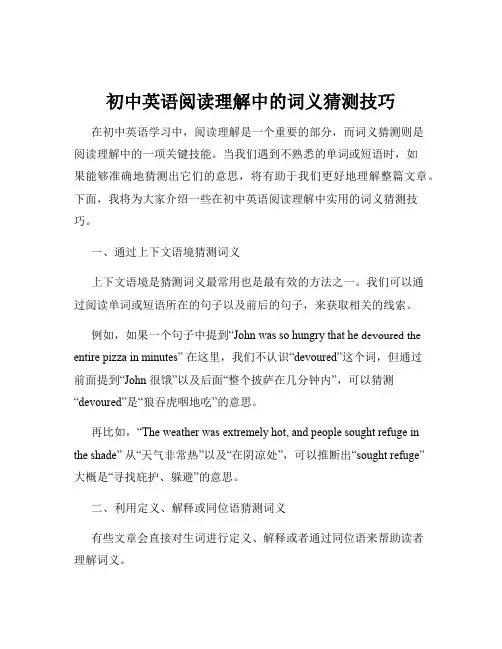
初中英语阅读理解中的词义猜测技巧在初中英语学习中,阅读理解是一个重要的部分,而词义猜测则是阅读理解中的一项关键技能。
当我们遇到不熟悉的单词或短语时,如果能够准确地猜测出它们的意思,将有助于我们更好地理解整篇文章。
下面,我将为大家介绍一些在初中英语阅读理解中实用的词义猜测技巧。
一、通过上下文语境猜测词义上下文语境是猜测词义最常用也是最有效的方法之一。
我们可以通过阅读单词或短语所在的句子以及前后的句子,来获取相关的线索。
例如,如果一个句子中提到“John was so hungry that he devoured the entire pizza in minutes” 在这里,我们不认识“devoured”这个词,但通过前面提到“John 很饿”以及后面“整个披萨在几分钟内”,可以猜测“devoured”是“狼吞虎咽地吃”的意思。
再比如,“The weather was extremely hot, and people sought refuge in the shade” 从“天气非常热”以及“在阴凉处”,可以推断出“sought refuge”大概是“寻找庇护、躲避”的意思。
二、利用定义、解释或同位语猜测词义有些文章会直接对生词进行定义、解释或者通过同位语来帮助读者理解词义。
比如,“A thermometer is an instrument used to measure temperature” 很明显,通过“is an instrument used to measure temperature”(是一种用来测量温度的仪器),我们能明白“thermometer”是“温度计”的意思。
又或者,“My sister, Mary, who is a doctor, always works very hard” 这里“who is a doctor”就是对“Mary”的同位语解释,让我们知道 Mary 的职业是医生。
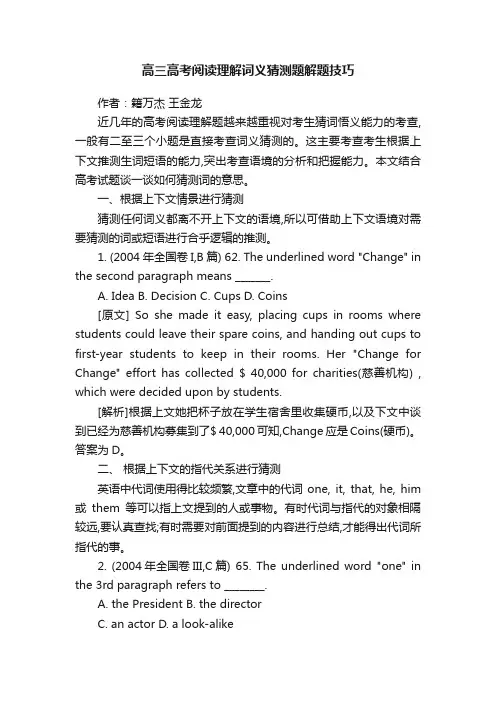
高三高考阅读理解词义猜测题解题技巧作者:籍万杰王金龙近几年的高考阅读理解题越来越重视对考生猜词悟义能力的考查,一般有二至三个小题是直接考查词义猜测的。
这主要考查考生根据上下文推测生词短语的能力,突出考查语境的分析和把握能力。
本文结合高考试题谈一谈如何猜测词的意思。
一、根据上下文情景进行猜测猜测任何词义都离不开上下文的语境,所以可借助上下文语境对需要猜测的词或短语进行合乎逻辑的推测。
1. (2004年全国卷I,B篇) 62. The underlined word "Change" in the second paragraph means _______.A. IdeaB. DecisionC. CupsD. Coins[原文] So she made it easy, placing cups in rooms where students could leave their spare coins, and handing out cups to first-year students to keep in their rooms. Her "Change for Change" effort has collected $ 40,000 for charities(慈善机构) , which were decided upon by students.[解析]根据上文她把杯子放在学生宿舍里收集硬币,以及下文中谈到已经为慈善机构募集到了$ 40,000可知,Change应是Coins(硬币)。
答案为D。
二、根据上下文的指代关系进行猜测英语中代词使用得比较频繁,文章中的代词one, it, that, he, him 或them等可以指上文提到的人或事物。
有时代词与指代的对象相隔较远,要认真查找;有时需要对前面提到的内容进行总结,才能得出代词所指代的事。
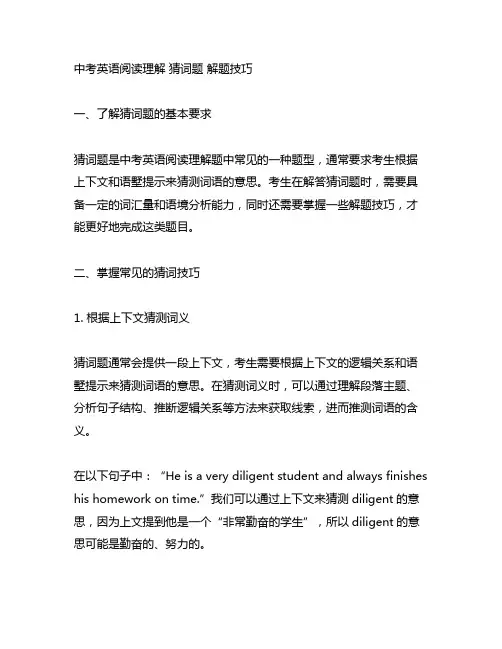
中考英语阅读理解猜词题解题技巧一、了解猜词题的基本要求猜词题是中考英语阅读理解题中常见的一种题型,通常要求考生根据上下文和语墅提示来猜测词语的意思。
考生在解答猜词题时,需要具备一定的词汇量和语境分析能力,同时还需要掌握一些解题技巧,才能更好地完成这类题目。
二、掌握常见的猜词技巧1. 根据上下文猜测词义猜词题通常会提供一段上下文,考生需要根据上下文的逻辑关系和语墅提示来猜测词语的意思。
在猜测词义时,可以通过理解段落主题、分析句子结构、推断逻辑关系等方法来获取线索,进而推测词语的含义。
在以下句子中:“He is a very diligent student and always finishes his homework on time.”我们可以通过上下文来猜测diligent的意思,因为上文提到他是一个“非常勤奋的学生”,所以diligent的意思可能是勤奋的、努力的。
2. 利用语境提示进行词义推断除了根据上下文猜测词义外,还可以利用语境提示进行词义推断。
比如一些词语的前后文会提供一些提示性的词语,这些提示性词语往往可以帮助我们推测目标词语的意思。
在以下句子中:“W hen the teacher asked a difficult question, the students looked puzzled.”我们可以通过后面的“looked puzzled”来推测difficult的意思,因为学生们显然是对这个问题感到困惑。
3. 掌握常见词义辨析技巧在解答猜词题时,有些词语的词义可能会让考生感到困惑,这时就需要掌握一些词义辨析技巧。
比如通过对比近义词或反义词的意思,来推测目标词语的含义。
在以下句子中:“The music was so loud that it was almost deafening.”我们可以通过对比loud和deafening的意思,来推测deafening的含义,因为loud表示“大声的”,而deafening应该表示“震耳欲聋的”。
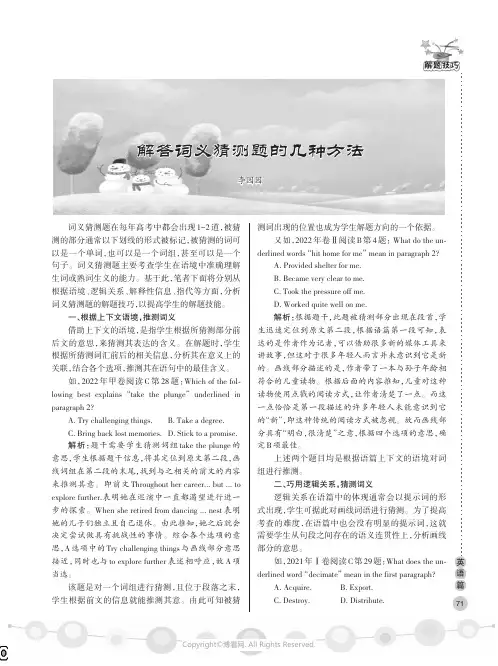
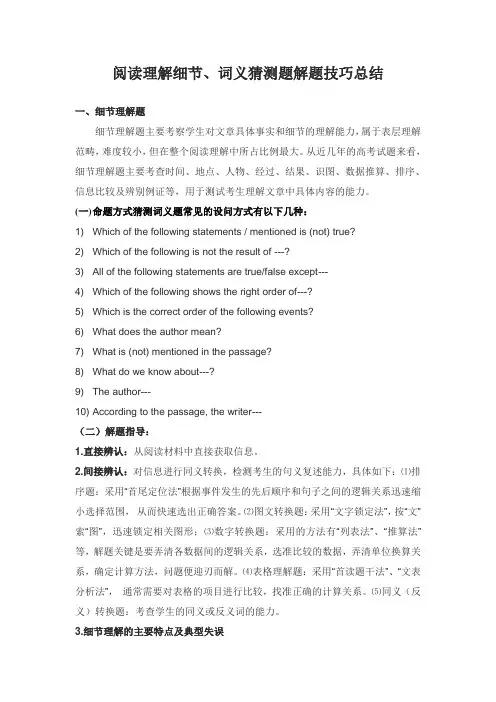
阅读理解细节、词义猜测题解题技巧总结一、细节理解题细节理解题主要考察学生对文章具体事实和细节的理解能力,属于表层理解范畴,难度较小,但在整个阅读理解中所占比例最大。
从近几年的高考试题来看,细节理解题主要考查时间、地点、人物、经过、结果、识图、数据推算、排序、信息比较及辨别例证等,用于测试考生理解文章中具体内容的能力。
(一)命题方式猜测词义题常见的设问方式有以下几种:1) Which of the following statements / mentioned is (not) true?2) Which of the following is not the result of ---?3) All of the following statements are true/false except---4) Which of the following shows the right order of---?5) Which is the correct order of the following events?6) What does the author mean?7) What is (not) mentioned in the passage?8) What do we know about---?9) The author---10) According to the passage, the writer---(二)解题指导:1.直接辨认:从阅读材料中直接获取信息。
2.间接辨认:对信息进行同义转换,检测考生的句义复述能力,具体如下:⑴排序题:采用“首尾定位法”根据事件发生的先后顺序和句子之间的逻辑关系迅速缩小选择范围,从而快速选出正确答案。
⑵图文转换题:采用“文字锁定法”,按“文”索“图”,迅速锁定相关图形;⑶数字转换题:采用的方法有“列表法”、“推算法”等,解题关键是要弄清各数据间的逻辑关系,选准比较的数据,弄清单位换算关系,确定计算方法,问题便迎刃而解。
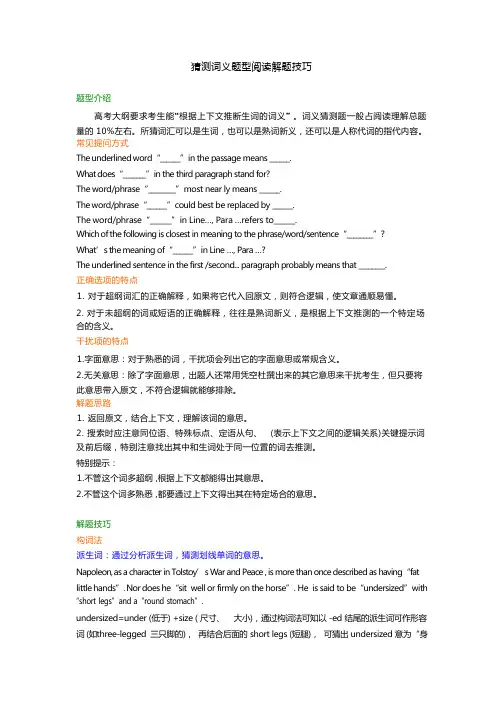
猜测词义题型阅读解题技巧题型介绍高考大纲要求考生能“根据上下文推断生词的词义”。
词义猜测题一般占阅读理解总题量的 10%左右。
所猜词汇可以是生词,也可以是熟词新义,还可以是人称代词的指代内容。
常见提问方式The underlined word“______”in the passage means ______.What does“_______”in the third paragraph stand for?The word/phrase“________”most near ly means ______.The word/phrase“______”could best be replaced by ______.The word/phrase“______”in Line…, Para …refers to______.Which of the following is closest in meaning to the phrase/word/sentence“________”?What’s the meaning of“______”in Line …, Para …?The underlined sentence in the first /second... paragraph probably means that ________.正确选项的特点1. 对于超纲词汇的正确解释,如果将它代入回原文,则符合逻辑,使文章通顺易懂。
2. 对于未超纲的词或短语的正确解释,往往是熟词新义,是根据上下文推测的一个特定场合的含义。
干扰项的特点1.字面意思:对于熟悉的词,干扰项会列出它的字面意思或常规含义。
2.无关意思:除了字面意思,出题人还常用凭空杜撰出来的其它意思来干扰考生,但只要将此意思带入原文,不符合逻辑就能够排除。
解题思路1. 返回原文,结合上下文,理解该词的意思。
2. 搜索时应注意同位语、特殊标点、定语从句、 (表示上下文之间的逻辑关系)关键提示词及前后缀,特别注意找出其中和生词处于同一位置的词去推测。
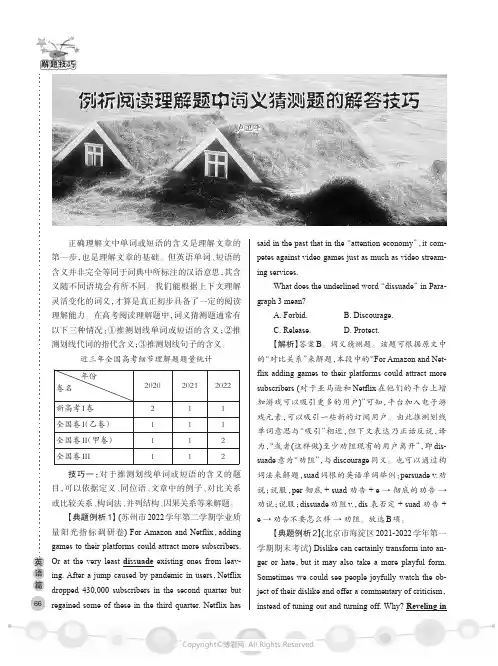
正确理解文中单词或短语的含义是理解文章的第一步,也是理解文章的基础。
但英语单词、短语的含义并非完全等同于词典中所标注的汉语意思,其含义随不同语境会有所不同。
我们能根据上下文理解灵活变化的词义,才算是真正初步具备了一定的阅读理解能力。
在高考阅读理解题中,词义猜测题通常有以下三种情况:①推测划线单词或短语的含义;②推测划线代词的指代含义;③推测划线句子的含义。
近三年全国高考细节理解题题量统计卷名年份新高考I卷全国卷I(乙卷)全国卷II(甲卷)全国卷III 202021112021111120221122技巧一:对于推测划线单词或短语的含义的题目,可以依据定义、同位语、文章中的例子、对比关系或比较关系、构词法、并列结构、因果关系等来解题。
【典题例析1】(苏州市2022学年第二学期学业质量阳光指标调研卷)For Amazon and Netflix,adding games to their platforms could attract more subscribers. Or at the very least dissuade existing ones from leav-ing.After a jump caused by pandemic in users,Netflix dropped430,000subscribers in the second quarter but regained some of these in the third flix has said in the past that in the“attention economy”,it com-petes against video games just as much as video stream-ing services.What does the underlined word“dissuade”in Para-graph3mean?A.Forbid.B.Discourage.C.Release.D.Protect.【解析】答案B。
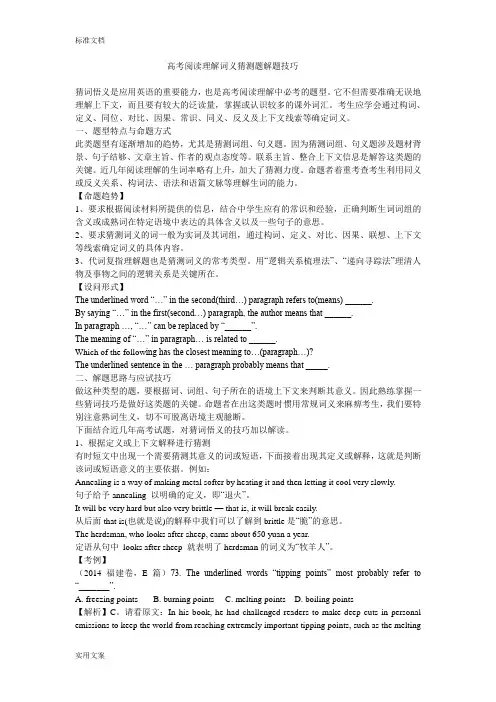
高考阅读理解词义猜测题解题技巧猜词悟义是应用英语的重要能力,也是高考阅读理解中必考的题型。
它不但需要准确无误地理解上下文,而且要有较大的泛读量,掌握或认识较多的课外词汇。
考生应学会通过构词、定义、同位、对比、因果、常识、同义、反义及上下文线索等确定词义。
一、题型特点与命题方式此类题型有逐渐增加的趋势,尤其是猜测词组、句义题。
因为猜测词组、句义题涉及题材背景、句子结够、文章主旨、作者的观点态度等。
联系主旨、整合上下文信息是解答这类题的关键。
近几年阅读理解的生词率略有上升,加大了猜测力度。
命题者着重考查考生利用同义或反义关系、构词法、语法和语篇文脉等理解生词的能力。
【命题趋势】1、要求根据阅读材料所提供的信息,结合中学生应有的常识和经验,正确判断生词词组的含义或成熟词在特定语境中表达的具体含义以及一些句子的意思。
2、要求猜测词义的词一般为实词及其词组,通过构词、定义、对比、因果、联想、上下文等线索确定词义的具体内容。
3、代词复指理解题也是猜测词义的常考类型。
用“逻辑关系梳理法”、“递向寻踪法”理清人物及事物之间的逻辑关系是关键所在。
【设问形式】The underlined word “…” in the second(third…) paragraph refers to(means) ______.By saying “…” in the first(second…) paragraph, the author means that ______.In paragraph …, “…” can be replaced by “______”.The meaning of “…” in paragraph… is related to ______.Which of the follow ing has the closest meaning to…(paragraph…)?The underlined sentence in the … paragraph probably means that _____.二、解题思路与应试技巧做这种类型的题,要根据词、词组、句子所在的语境上下文来判断其意义。
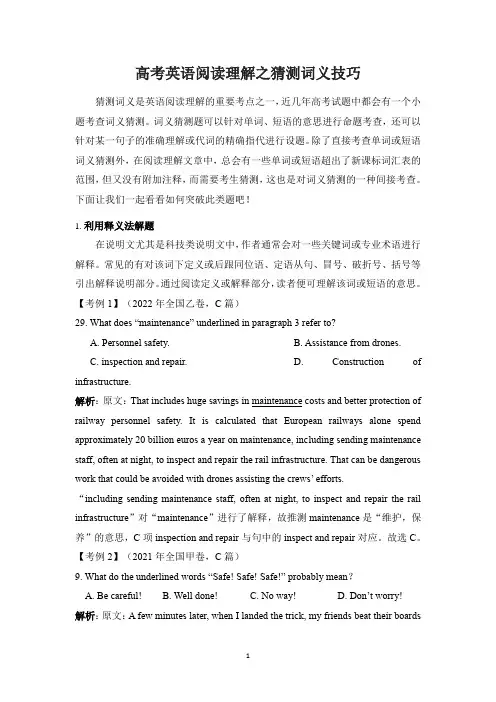
高考英语阅读理解之猜测词义技巧猜测词义是英语阅读理解的重要考点之一,近几年高考试题中都会有一个小题考查词义猜测。
词义猜测题可以针对单词、短语的意思进行命题考查,还可以针对某一句子的准确理解或代词的精确指代进行设题。
除了直接考查单词或短语词义猜测外,在阅读理解文章中,总会有一些单词或短语超出了新课标词汇表的范围,但又没有附加注释,而需要考生猜测,这也是对词义猜测的一种间接考查。
下面让我们一起看看如何突破此类题吧!1.利用释义法解题在说明文尤其是科技类说明文中,作者通常会对一些关键词或专业术语进行解释。
常见的有对该词下定义或后跟同位语、定语从句、冒号、破折号、括号等引出解释说明部分。
通过阅读定义或解释部分,读者便可理解该词或短语的意思。
【考例1】(2022年全国乙卷,C篇)29. What does “maintenance” underlined in paragraph 3 refer to?A. Personnel safety.B. Assistance from drones.C. inspection and repair.D. Construction of infrastructure.解析:原文:That includes huge savings in maintenance costs and better protection of railway personnel safety. It is calculated that European railways alone spend approximately 20 billion euros a year on maintenance, including sending maintenance staff, often at night, to inspect and repair the rail infrastructure. That can be dangerous work that could be avoided with drones assisting the crews’ efforts.“including sending maintenance staff, often at night, to inspect and repair the rail infrastructure”对“maintenance”进行了解释,故推测maintenance是“维护,保养”的意思,C项inspection and repair与句中的inspect and repair对应。
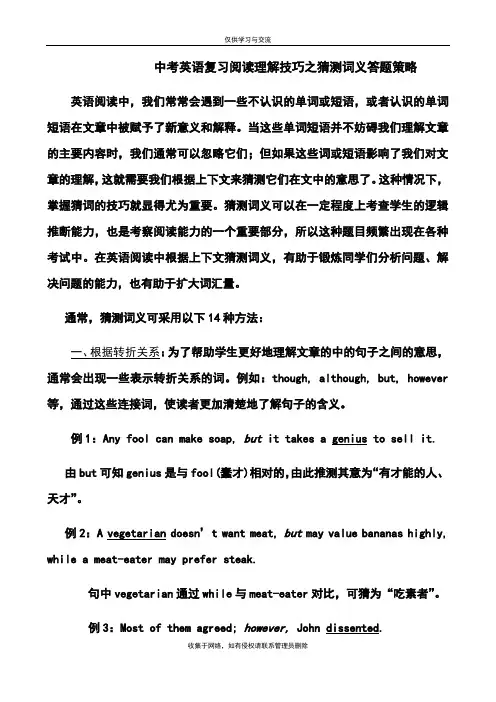
中考英语复习阅读理解技巧之猜测词义答题策略英语阅读中,我们常常会遇到一些不认识的单词或短语,或者认识的单词短语在文章中被赋予了新意义和解释。
当这些单词短语并不妨碍我们理解文章的主要内容时,我们通常可以忽略它们;但如果这些词或短语影响了我们对文章的理解,这就需要我们根据上下文来猜测它们在文中的意思了。
这种情况下,掌握猜词的技巧就显得尤为重要。
猜测词义可以在一定程度上考查学生的逻辑推断能力,也是考察阅读能力的一个重要部分,所以这种题目频繁出现在各种考试中。
在英语阅读中根据上下文猜测词义,有助于锻炼同学们分析问题、解决问题的能力,也有助于扩大词汇量。
通常,猜测词义可采用以下14种方法:一、根据转折关系:为了帮助学生更好地理解文章的中的句子之间的意思,通常会出现一些表示转折关系的词。
例如:though, although, but, however 等,通过这些连接词,使读者更加清楚地了解句子的含义。
例1:Any fool can make soap, but it takes a genius to sell it.由but可知genius是与fool(蠢才)相对的,由此推测其意为“有才能的人、天才”。
例2:A vegetarian doesn’t want meat, but may value bananas highly, while a meat-eater may prefer steak.句中vegetarian通过while与meat-eater对比,可猜为“吃素者”。
例3:Most of them agreed; however, John dissented.句中dissented通过however与agreed对比, dissented意思是“反对”。
二、根据对比关系:在一个句子或段落中,有对两个事物或现象进行对比性的描述,我们可以根据生词或难词的反义词猜测其词义。
表示对比关系的词汇和短语主要有:unlike, not, while, on the other hand, in spite of, in contrast等。
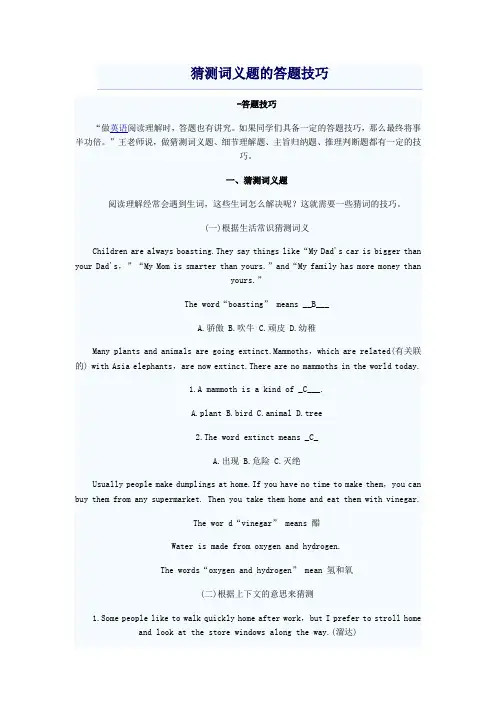
-答题技巧“做英语阅读理解时,答题也有讲究。
如果同学们具备一定的答题技巧,那么最终将事半功倍。
”王老师说,做猜测词义题、细节理解题、主旨归纳题、推理判断题都有一定的技巧。
一、猜测词义题阅读理解经常会遇到生词,这些生词怎么解决呢?这就需要一些猜词的技巧。
(一)根据生活常识猜测词义Children are always boasti ng.They say things like“My Dad's car is bigger than your Dad's,”“My Mom is smarter than yours.”and“My family has more money thanyours.”The word“boasting” means __B___A.骄傲B.吹牛C.顽皮D.幼稚Many plants and animals are going extinct.Mammoths,which are related(有关联的) with Asia elephants,are now extinct.There are no mammoths in the world today.1.A mammoth is a kind of _C___.A.plantB.birdC.animalD.tree2.The word extinct means _C_A.出现B.危险C.灭绝Usually people make dumplings at home.If you have no time to make them,you can buy them from any supermarket. Then you take them home and eat them with vinegar.The wor d“vinegar” means 醋Water is made from oxygen and hydrogen.The words“oxygen and hydrogen” mean 氢和氧(二)根据上下文的意思来猜测1.Some people like to walk quickly home after work,but I prefer to stroll homeand look at the store windows along the way.(溜达)2.She is usually prompt for all her classes,but today she arrives quite late.(准时的)3.The door is so low that I hit my head on the lintel.(门梁)(三)根据转折、因果关系猜测词义通过因果关系猜词,首先是找出生词与上下文之间的逻辑关系,然后才能猜词。
词义猜测题解题技巧词义猜测题是中考英语阅读理解题中必考题之一,主要考查同学们语篇分析、逻辑推理等综合能力。
解题时,同学们要注意把握技巧,根据上下文逻辑关系、标点符号、构词规则等,准确猜测生词词义。
一、词义猜测类题目常见的设问方式:1.The word"..."refers to/probably means_____.2.The underlined word "..." could best be replaced by_.3.What does the expression"..."stand for?4.By saying"..."we mean____.5."..."as used in the passage can best be defined as___——·6.Which of the following words can take the place of the word"..."?二、词义猜测题是指利用语境(上下文)推测、判断某些生词词义的题。
在近几年的高考阅读试题中词义猜测题的考查力度逐步加大。
词义猜测是一项阅读技巧,主要考查考生根据上下文推断单词意思的能力。
因此,所考单词的意义通常超出大纲范围——超纲词义含义推断、熟词生义或熟词在特定语境中的意思。
词义猜测题常考查对句中关键性词语(实词、短语、指代关系等)的理解。
三、【解题流程】“一原则”、“二关注”速解词义猜测题一原则结合上下文词义猜测题所提问的单词、词组或句子一般都是考生不认识的,即使认识,正确答案也未必是熟悉的含义。
这种题目目的就是希望考生能结合上下文,来理解不认识的单词、词组或句子。
二关注关注并列转折部分这是做词义猜测题的一大利器。
因为由并列转折连接的两部分会存在语义含义和成分的对应。
⼀、根据释义猜测词义在有些⽂章中,某些⽣词的词义在下⽂中可以得到解释或说明。
这些解释有时以定义、定语从句、同位语形式出现;有时⽤破折号、括号、冒号、引号等符号引出;还有时⽤that is,or,that is to say,in other words等次引出。
例如:1.Anthropology is the scientific study of man.有定义可知,anthropology就是“研究⼈类的科学”,由此可推出anthropology是“⼈类学”。
2.He takes a special interest in botany which concerns the study of plants.根据定语从句中which concerns the study of plants 可知botany是“植物学”。
3.Capacitance,the ability to store electric charge,is one of the most common characteristics of electronic circuits.由同位语我们可以很快猜出⽣词capacitance的词义——————电容量。
4.The doctor was on the night-shift—from midnight to 8 o'clock.这⾥night-shift的意思可以由破折号后⾯的内容猜出,意思是“夜班”。
5.They are vertebrates,that is,animals that have backbones.这⾥vertebrates的意思可以由that is后⾯的内容猜出,意思是“脊椎动物”。
⼆、通过下⽂所举的例⼦猜测词义在有些⽂章中,下⽂所举的例⼦给读者提供了猜测⽣词的重要线索。
例如:Generally,we like to read periodicals,such as Time Magazine,Newsweek,Reader’sDigest,etc.根据后⾯所举的例⼦可以推断出periodicals的意思是“期刊”。
初三英语阅读理解技巧词义猜测题的解题技巧初三英语阅读理解技巧:词义猜测题的解题技巧在初三英语的学习中,阅读理解是一个重要的部分,而词义猜测题则是阅读理解中的常见题型。
对于很多同学来说,这类题目可能具有一定的挑战性,但只要掌握了正确的解题技巧,就能轻松应对。
接下来,我将为大家详细介绍初三英语阅读理解中词义猜测题的解题技巧。
一、通过上下文语境猜测词义上下文语境是猜测词义最常用也是最有效的方法之一。
在阅读过程中,我们可以通过前后的句子、段落来推断生词的含义。
例如,如果生词前后出现了解释说明的语句,那么这些语句往往能帮助我们理解词义。
比如:“The term ‘ecosystem’ refers to a communityof living organisms and their environment ”在这个句子中,“refers to”后面的内容就是对“ecosystem”这个词的解释,即“生态系统是指生物群落及其环境”,从而我们可以理解“ecosystem”的意思。
再比如,有时候上下文会通过对比、类比的方式来暗示生词的词义。
如果文中提到“A is different from B B is known as a kind of vehicle, whileA is a tool used for writing ”那么我们就可以推测出 A 可能是某种书写工具。
此外,上下文的逻辑关系也能为词义猜测提供线索。
比如因果关系、转折关系等。
如果文中说“Although he was very tired, he still insisted on working ”通过“although”所表示的转折关系,我们可以猜测“insisted on”可能有“坚持”的意思。
二、利用构词法猜测词义英语中有很多单词是通过构词法构成的,了解常见的构词法可以帮助我们猜测词义。
前缀和后缀是常见的构词元素。
比如“un”“dis”“in”等前缀通常表示否定;“ful”“less”“able”“ous”等后缀可以改变单词的词性和意思。
阅读理解中的词义猜测技巧及练习阅读理解是学习过程中必不可少的一项技能,而在阅读理解过程中,词义猜测是非常重要的一环。
通过正确猜测词义,我们能更好地理解文章内容,提高阅读效果。
本文将介绍一些词义猜测的技巧,并提供一些练习。
一、从上下文推测词义在阅读理解中,我们可以通过上下文的线索来推测生词的词义。
上文或下文中的其他单词、短语、句子可以提供关于生词意义的信息。
例如:1. 同义词法推测:当遇到一个生词时,我们可以寻找上下文中是否有与其意思相近的词,从而推测出生词的意义。
比如,当我们遇到"tiny"这个生词,而在上文中提到了"small"这个词,我们可以推测出"tiny"的意思是非常小的。
2. 反义词法推测:有时,我们可以通过寻找上下文中的反义词来推测生词的意义。
例如,当遇到"happy"这个生词时,在上文中提到了"unhappy",我们可以推测"happy"的意思是快乐的。
3. 举例法推测:在阅读理解中,有时会出现对生词进行解释的例子。
例如,当遇到一个生词"pessimistic"时,下文中提到了"always seeing the negative side",我们可以推测出"pessimistic"的意思是看问题时总是看到负面的。
二、根据词缀推测词义词缀是词根的前缀或后缀,可以给出单词的一些含义线索。
通过熟悉常见的词缀,我们可以在阅读理解中更准确地猜测生词的意义。
例如:1. 前缀推测:当遇到以"un-"作为前缀的生词时,我们可以推测出它们有否定的意思。
比如,"unclear"的意思是不清楚的,"unhappy"的意思是不快乐的。
2. 后缀推测:当遇到以"-ful"作为后缀的生词时,可以推测出它们表示充满某种特性或具有某种特性。
高考阅读理解题型中的词义推测题解题技巧在高考阅读理解题型中,词义推测题是考察考生对词汇理解和推理能力的重要试题之一。
正确解答词义推测题不仅对于理解文章整体意义有帮助,也对于提高解题效率和得分能力具有重要意义。
本文将介绍一些解答词义推测题的技巧,帮助考生在高考中取得好成绩。
一、上下文推测法上下文推测法是解答词义推测题的基本方法之一。
考生可以通过上下文的暗示来推测生词的意思。
在阅读理解题中,通常会出现一些生词或者不常见的词汇,而这些词汇往往是答题的关键。
通过仔细观察前后文,考生可以找到一些线索,从而推测出生词的含义。
例如,在某篇文章中出现了“sophisticated”一词,而该词前面描述了一个人拥有高级的教育背景和品味,可以推测该词的含义是“高端的”或“复杂的”。
二、词根词缀法词根词缀法是解答词义推测题的常用方法之一。
通过对词根和词缀的分析,考生可以推测出生词的意思。
很多生词都有固定的词根和词缀,通过了解这些词根和词缀的含义,可以帮助考生推测出生词的大致意义。
例如,“bi-”表示“两个”、“双重”,“cycle”表示“循环”,那么“bicycle”就可以推测为“双车轮”、“脚踏车”。
三、词义辨析法词义辨析法是解答词义推测题的有效方法之一。
有时候在选项中会出现一些与已知词义相近的词汇,通过对这些词汇的辨析,可以帮助考生确定正确的答案。
辨析的方法包括对比词义、对比词性、对比语境等。
例如,在原文中出现了“carefully”,而选项中有“cautiously”和“carelessly”,通过对比这两个词的词义,可以确定“carefully”的意思是“小心地”,而不是“粗心地”。
四、语境逻辑法语境逻辑法是解答词义推测题的一种高级方法。
通过观察句子结构、谓语动词、逻辑关系等,考生可以推测出生词的意思。
有时候句子的结构和逻辑关系会帮助考生确定生词的含义,因此考生需要仔细分析句子的结构和上下文之间的关系。
例如,如果一个句子中出现了“但是”、“然而”,那么后面很可能出现一个与之前观点相反的词汇或者短语。
高一英语培优材料词义猜测题的解题技巧这类题包括词义猜测和句意猜测两类;词义又包括单词和短语意义。
近几年的高考阅读理解题中一般有2至3个小题是直接考查词句意义猜测的。
对词义考查主要有对生词词义的推测和对熟词生义的推测或是在特定场合下对词或句子的理解。
这里着重谈一谈如何猜测词的意思。
1、根据转折关系根据上下句之间表示转折或对比关系的连接词,如but, however, otherwise, though等就可以看到前后句在意义上的差别,从而依据某一句的含义,来确定另一词的含义。
另外,分号也可以表示转折,对比或不相干的意义。
如:例1:Any fool can make soap, but it takes a genius to sell it. (广东卷)What does genius mean? _____________________例2:A child’s birthday party doesn’t have to be a hassle; it can be a basket of fun, according to Beth Anaclerio, an Evaston mother of two, ages 4 and 18 months. (全国卷)·What does the underlined word “hassle” probably mean?A. A party designed by specialistsB. A plan requiring careful thoughtC. A situation causing difficulty or troubleD. A demand made by guests2、根据对比关系表示对比关系的标志词有:unlike, not, while, on the other hand, in spite of, in contrast等。
猜测词义题型阅读解题技巧题型介绍高考大纲要求考生能“根据上下文推断生词的词义”。
词义猜测题一般占阅读理解总题量的10%左右。
所猜词汇可以是生词,也可以是熟词新义,还可以是人称代词的指代内容。
常见提问方式The underlined word “______”in the passage means ______.What does “_______” in the third paragraph stand for?The word/phrase “________” most near ly means ______.The word/phrase “______” could best be replaced by ______.The word/phrase “______” in Line…, Para …refers to______.Which of the following is closest in meaning to the phrase/word/sentence “________”?What’s the meaning of “______” in Line …, Para …?The underlined sentence in the first /second... paragraph probably means that ________.正确选项的特点1. 对于超纲词汇的正确解释,如果将它代入回原文,则符合逻辑,使文章通顺易懂。
2. 对于未超纲的词或短语的正确解释,往往是熟词新义,是根据上下文推测的一个特定场合的含义。
干扰项的特点1.字面意思:对于熟悉的词,干扰项会列出它的字面意思或常规含义。
2.无关意思:除了字面意思,出题人还常用凭空杜撰出来的其它意思来干扰考生,但只要将此意思带入原文,不符合逻辑就能够排除。
解题思路1. 返回原文,结合上下文,理解该词的意思。
2. 搜索时应注意同位语、特殊标点、定语从句、(表示上下文之间的逻辑关系)关键提示词及前后缀,特别注意找出其中和生词处于同一位置的词去推测。
特别提示:1.不管这个词多超纲,根据上下文都能得出其意思。
2.不管这个词多熟悉,都要通过上下文得出其在特定场合的意思。
解题技巧构词法派生词:通过分析派生词,猜测划线单词的意思。
Napoleon, as a character in Tolstoy’s War and Peace, is more than once described as having “fat little hands”. Nor does he “sit well or firmly on the horse”. He is said to be “undersized” with “short legs” and a “round stomach”.undersized=under (低于) +size (尺寸、大小),通过构词法可知以-ed结尾的派生词可作形容词(如three-legged 三只脚的),再结合后面的short legs (短腿),可猜出undersized意为“身材矮小的”。
Overwork may cause diseases.前缀over-的意思是“过分的,过量的”,故overwork 的意思应为“工作过度”。
There was a dissatisfied look in the manager’s eyes.satisfied 的意思是“满意的”,前缀dis-的意思是“不”,故dissatisfied的意思应该是“不满意的”。
合成法:指由两个或两个以上单词组合成一个新词。
通常情况下,合成词的词义为组成词的词义之和。
He never wore ready-made clothes.ready-made由ready和made加连字符合成一个词,该词在clothes前,可知其词性为形容词,结合各个词的本意:ready“准备就绪的”,made“做好的”,可知句中的ready-made是“现成的、做好的”的意思。
转化法:指单词的词形不改变,只通过词性的改变来使单词具有新的意义和作用。
而这种单词叫转化词。
Great cultural changes led to more open communication and a more democratic process that encourages everyone to have a say.say一般作动词,意为“说、表达”。
观察句子,say前面带a,表示say在此转化为名词,意为“发言权、决定权”。
语境法利用释义词(句)、举例或同位语:同位语是对所修饰词语的进一步说明和解释,若对所修饰的词语不熟悉,可通过其后同位语的“说明或解释”来确定其词义。
表示释义或举例词语的信息词有for example, for instance, such as, in other words, that is to say, namely, or, also known as, to put it differently, refer to等,符号则有e.g. (举例) 、i.e. (也就是) 。
In fact, only about 80 ocelots, an endangered wild cat, exist in the U.S. today.利用生词后面的同位语an endangered wild cat,可知ocelot是一种猫。
Yes, that is the Tai Mahal, one of the most famous buildings in the world. (全国卷)由后面的同位语的解释我们清楚地知道Tai Mahal就是一座著名的建筑物。
A linguist is a person who studies the science of language.Linguist就是一个“研究语言科学的人”,即“语言学家”。
They described him as a loon, or a mad man.句中的or是对loon的解释,即loon与a mad man同义,即表示“疯子”。
It will be very hard but also very brittle, that is, it will break easily.句中的that is表明it will break easily是对brittle的解释,从而猜测出其意为“易碎的”。
“脆的”In the ancient city of Rome, we visited every mansion, battle site, theatre and other public halls.因为mansion与“战场遗址”、“剧院”、“其它公众厅”并列,所以mansion也应该属于建筑物或场所。
利用对比、类比或转折词表示对比、类比或转折的常见信息词有but, yet, however, while, unlike, in contrast, on the other hand, on the contrary, despite, in spite of, instead, rather than, though等,有时也用破折号或冒号等符号。
Any fool can make soap, but it takes a genius to sell it.由but可知genius是与fool(蠢才)相对的,由此推测其意为“有才能的人”、“天才”。
He had been getting better, but during the night his condition deteriorated.句中的but表明deteriorate应该与get better的意思相反,即“恶化”。
In many countries there are two financial extremes, from penury to great wealth.上文说两个经济上的极端,那么下文中penury应与great wealth相对,即表示“贫困”。
Mrs. Smith is loquacious while her husband is the silent type.while表对比,意为“而”,所以loquacious应是silent的反义,即“多嘴的”。
If you agree, draw a circle; and a cross if you dissent.既然画圈表示同意,画叉便是“不同意”(dissent)。
利用因果关系表示因果关系的信息词有because, as, since, for, thus, so, so\such… that, hence, therefore, as a result等。
That museum is so immense that it will be impossible to see all the exhibits in one day.既然一天之内看不完所有的展品,那么immense 的意思应该是“很大”了。
Everyone agreed that the woman in the photo was gorgeous. It was easy to see why she had won the beauty contest.既然“她在选美比赛中获胜”,说明她“很美丽”(gorgeous)。
利用上下文(结合生活常识、背景知识)猜测词义题在考查熟词新义以及代词指代内容时往往需要综合考虑上下文,有时也需要结合常识和背景知识。
It’s said that B ill Gates is the most affluent person in the world.根据常识,Bill Gates 为世界首富,所以affluent 可能是“富有的”。
As a scientist, Edison is very famous for his contrivances.根据常识,Edison为发明大王,他应因“发明”而闻名于世。
The snake slithered through the grass.根据有关蛇的生活习性的知识,我们可以推断出slither的词义为“爬行”。
真题再现1.What does “hands-on-science” mean in the last paragraph?A. Science games designed by kids.B. Learning science by doing things.C. A show of kids’ science work.D. Reading science books.Try hands-on-science. Visit one of the many hands-on-science museums around the country. These science play-lands are great fun for kids and grown-ups alike.2.What do the words “the follower” in paragraph 2 refer to?A. A bee.B. A bird.C. A honey seeker.D. A beekeeper.Once it has their attention, it flies through the forest, waiting from time to time for the curious animal or person as it leads them to the nest. When they finally arrive at the nest, the follower reaches in to get at the delicious honey as the bird patiently waits and watches.3.What does the word “It” underlined in Paragraph 4 refer to?A. The boat.B. The wind.C. The sail.D. The angle.In this case, you must keep the sail half way outside the boat; it should be at a 45 degree angle to the boat. It needs to be out eno ugh to catch the wind, but it shouldn’t flap (摆动).4.What do the words “a replica” in Paragraph 2 refer to?A. A painting of the skeleton (骨骼).B. A photograph of Lucy.C. A copy of the skeleton.D. A written record of Lucy.The Lucy on exhibition at the Ethiopian National Museum in the capital, Addis Ababa, is a replica while the real remains are usually locked in a secret storeroom.5.If humans were truly at home under the light of the moon and stars, we would go in darkness happily, the midnight world as visible to us as it is to the vast number of nocturnal(夜间活动的) species on this planet. Instead, we are diurnal creatures, with eyes adapted to living in the sun's light. This is a basic evolutionary fact, even though most of us don't think of ourselves as diurnal beings. Yet it's the only way to explain what we’ve done to the night: We've engineered it to receive us by filling it with light.What does “it” (Paragraph 1) most probably refer to?A. The night.B. The moon.C. The sky.D. The planet.6.They didn’t. From day two (everyone wanted to walk the cute puppy that first day), neither thought to walk the dog. While I was slow to accept that I would be the one to keep track of her shots, to schedule her vet appointments, to feed and clean her, Misty knew this on day one. As she looked up at the three new humans in her life (small, medium, and large), she calculated, “The medium one is the sucker in the pack.”Which of the following is the closest in meaning to "The medium one is the suc ker in the pack.” (Paragraph 3)?A. “The middle-aged person loves me most.”B. “The medium-sized woman is the hostess.”C. “The man in the middle is the one who has the final say.”D. “The woman is the kind and trustworthy one in the family.”7. Thus, Papa insisted that we learn at least one new thing each day. Though, as children, we thought this was crazy, it would never have occurred to us to deny Papa a request. And dinner time seemed perfect for sharing what we had learned. We would talk about the news of the day; no matter how insignificant, it was never taken lightly. Papa would listen carefully and was ready with some comment, always to the point.The underlined word “it” in the second paragraph refers to _______.A. one new thingB. a requestC. the newsD. some comment8.In the evening, rides are usually at a more relaxed and unhurried pace, with golden light streaming across the grassy delta and the animals coming out to eat and drink. Sedate though they are, rides at this time of day are still very impressive. As the sun’s rays pass through the dust kicked up by the horses, the romance of Africa comes to life.What does the underlined word “Sedate” probably mean?A. Wild and romantic.B. Slow and peaceful.C. Hungry and thirsty.D. Active and excited.9. Determined, Dad filled our plates with steaming stew and passed them around. It didn’t look that bad, and after the first wave had shut do wn my ability to smell, it didn’t offend the nose so much, either. I took a taste. It would never win a prize in a cooking competition, but it was surprisingly edible, and we drank up every last drop of soup.What does the underlined word “offend” in the l ast paragraph mean?A. To attractB. To upsetC. To airD. To shut10. There are three kinds of snow. One kind is a fluffy snow that is somewhat dry and feathery?11. Jean was born with spina bifida, a birth illness that damages the spine(脊骨).12. We studied the board critically. Some of us looked with one eye and held up certain colors against the blackboard, rocking the sheets to the right or left while we conjured up our designs. Others twisted their hair around their fingers or chewed their erasers while deep in thought.The underlined phrase in paragraph 3 most probably means _____________.A. formed an idea forB. made an outline forC. made some space forD. chose some colors for13. You have no power and could do nothing that helps change the situation. However, you canhave great power over what happens to you if you stop focusing on whom to blame and start focusing on how to remedy the situation. This is the winner’s key to success.The underlined word remedy in Paragraph 1 is closest in meaning to .A. avoidB. acceptC. improveD. consider14. The house looked quite normal outside, but inside it was very exotic with fascinating objects on display. As he began putting them into his bag, a dog came into the room. It stopped when it saw Buster, then wagged its tail madly and went over to him. Buster whispered. “What a great guard dog you are——trying to lick me to death.”Which of the definitions is closest in meaning to the word “exotic”?A. Messy and untidy.B. Rich and expensive.C. Comfortable and calming.D. Unusual and foreign15. I thought to myself that we adults usually make a big “to do” over the younger one because she is the one who seems more easily hurt. We do it with the best of intentions.The underlined expression make a big “to do” over means ______.A. show much concern aboutB. have a special effect onC. list jobs to be done forD. do good things for16. I left university with a good degree in English Literature, but no sense of what I wanted to do. Over the next six years, just trying to earn an income,I was treading water. Because I tried journalism, but I didn’t think I was any good, then finance, which I hated. Finally, I got a job as a rights assistant at a famous publisher. I loved working with books, although the job that I did was dull.What does the underlined part in Paragraph 1 mean?A. I was waiting for good fortune.B. I was trying to find an admirable job.C. I was being aimless about a suitable job.D. I was doing several jobs for more pay at a time17. Born in Chicago in 1902, brought up and schooled in Nebraska, the 19-year-old college graduate Ralph Tyler became hooked on teaching while teaching as a science teacher in South Dakota and changed his major from medicine to education.The words “hooked on teaching” underlined in Paragraph 2 probably mean ___________.A. attracted to teachingB. tired of teachingC. satisfied with teachingD. unhappy about teaching18. One morning, however, I found its bed empty. My doll was gone! I cried for it. Mum wept andtold me that the poor little thing had been sent to a hospital. It had a fever. For several days, I heard Mum and Dad whispering such words as “hopeless”, “pitiful”, and “dying”, which sounded ominous.What does the underlined word “ominous” in Paragraph 3 probably mean?A. Impossible.B. BoringC. DifficultD. Fearful答案与解析1. B。